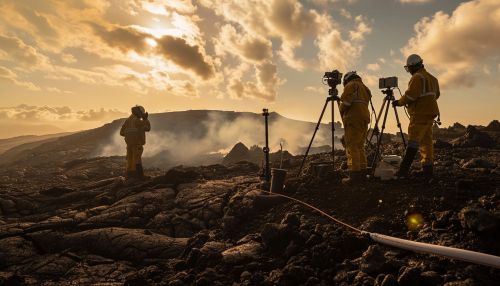Volcano Eruption Prediction and Monitoring
Introduction
Volcano eruption prediction and monitoring is a critical aspect of volcanology, the scientific study of volcanoes and volcanic phenomena. This field of study aims to understand the processes involved in volcanic eruptions, predict their occurrence, and monitor their activity to mitigate the potential hazards associated with these natural disasters.
The Science of Predicting Volcano Eruptions
Predicting volcanic eruptions is a complex task that involves a deep understanding of the geological processes that lead to an eruption. Scientists use a variety of methods to predict eruptions, including the analysis of seismic activity, gas emissions, ground deformation, and other geophysical and geochemical signals.


Seismic Monitoring
Seismic activity is often the first sign of an impending volcanic eruption. Volcanoes often produce small earthquakes, known as volcanic seismicity, which can indicate that magma is moving beneath the surface. Scientists use seismometers to detect and measure these earthquakes, and the data collected can help predict when and where an eruption might occur.
Gas Monitoring
Volcanoes emit various gases, including water vapor, carbon dioxide, sulfur dioxide, and other volatile substances. The composition and quantity of these gases can provide valuable clues about the state of a volcano. For instance, an increase in sulfur dioxide emissions can indicate that magma is rising to the surface, a possible precursor to an eruption. Gas monitoring is typically done using gas sensors placed on the volcano or through remote sensing techniques such as satellite imagery.
Ground Deformation Monitoring
Ground deformation refers to changes in the shape of the volcano, often caused by the movement of magma beneath the surface. This can be monitored using various techniques, including GPS measurements, tiltmeters, and InSAR (Interferometric Synthetic Aperture Radar) imaging. These methods can detect even minor changes in the volcano's shape, providing further insight into its activity.
Volcano Monitoring Systems
Various volcano monitoring systems have been developed to collect and analyze data from active volcanoes. These systems typically involve a network of sensors and instruments that continuously monitor seismic activity, gas emissions, and ground deformation. The data collected is then analyzed by volcanologists to assess the volcano's activity and predict potential eruptions.
Ground-Based Monitoring
Ground-based monitoring involves the use of instruments placed directly on or near the volcano. This can include seismometers, gas sensors, tiltmeters, and other devices. These instruments provide real-time data on the volcano's activity, allowing for immediate response to any changes.
Satellite Monitoring
Satellite monitoring involves the use of satellites to collect data on volcanic activity from space. This can include measurements of gas emissions, thermal imaging to detect heat from an eruption, and InSAR imaging to monitor ground deformation. Satellite monitoring provides a global perspective on volcanic activity and can be particularly useful for monitoring remote or inaccessible volcanoes.
Remote Sensing
Remote sensing involves the use of instruments located at a distance from the volcano to collect data. This can include radar, lidar, and other technologies. Remote sensing allows for the monitoring of volcanoes in hazardous or hard-to-reach areas and can provide valuable data on changes in the volcano's activity.
Challenges in Volcano Eruption Prediction and Monitoring
Despite advances in technology and understanding of volcanic processes, predicting and monitoring volcanic eruptions remain challenging. Factors such as the complex nature of volcanic systems, the unpredictability of eruptions, and the limitations of monitoring equipment can all pose challenges to accurate prediction and monitoring.
Complex Nature of Volcanic Systems
Volcanic systems are complex and can behave in unpredictable ways. Factors such as the composition and viscosity of the magma, the structure of the volcano, and the interaction with the surrounding environment can all influence when and how a volcano erupts. This complexity makes it difficult to predict eruptions with complete accuracy.
Unpredictability of Eruptions
While certain signs often precede volcanic eruptions, these signs do not always lead to an eruption. In some cases, a volcano may show signs of increased activity, such as increased seismic activity or gas emissions, but not erupt. This unpredictability can make it difficult to accurately predict eruptions and can lead to false alarms.
Limitations of Monitoring Equipment
While modern monitoring equipment can provide valuable data on volcanic activity, these instruments have their limitations. For instance, seismometers can detect earthquakes caused by magma movement, but they cannot determine the exact location or depth of the magma. Similarly, gas sensors can detect changes in gas emissions, but they cannot provide a complete picture of the volcano's gas composition.
Conclusion
Volcano eruption prediction and monitoring is a complex and challenging field, but it is crucial for mitigating the risks associated with volcanic eruptions. By understanding the processes that lead to eruptions and developing effective monitoring systems, scientists can better predict eruptions and provide early warnings to communities at risk.
